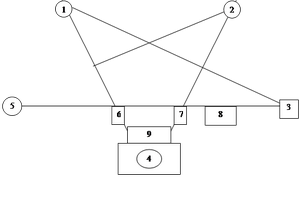Geomachy
From Plastic Tub
|
The D.C. Pentagram is a configuration of streets in Washington, D.C. which many claim is evidence of a Freemasonic and/or Satanic conspiracy within the U.S. Government. While these claims are neither supported nor refuted by Plastic Tub, the fact remains that there is in fact a very visible, if incomplete pentagram formed in the D.C. street plan; here are the particulars, along with some pertinent remarks about Freemasonic connections, for your perusal and edification. The center of D.C. was originally designed by Pierre Charles L'Enfante, a Frenchman who had attained the rank of Major in the Continental Army. L'Enfante is known to have infused his design with symbolic purpose. For example, his dislike for Justice John Jay is widely credited as the reason why his plan skipped J Street in the D.C. layout (I Street is adjacent to K street.) L'Enfant's plan was significantly modified by surveyor Andrew Ellicott and his assistant Benjamin Bannaker when they began their work in 1791. None of the three men were Freemasons. Over time, Washington evolved naturally and the street plan strayed from L'Enfant's vision. At one point, what is now the National Mall was a muddy field used for grazing cattle and marred by an ugly railway station. In 1901, a Commission chaired by Senator James McMillan of Michigan was formed to restore the Mall to L'Enfant's original vision. Among the experts he engaged was Frederick Law Olmsted, Jr., a landscape architect who was, like McMillan, not a Freemason. Olmstead did, however, previously redesign the Capitol building grounds, in 1874. That design is of interest in AA circles because of its purported resemblance to an owl. Major points on the D.C. Pentagram
Tracing the Pentagram Dupont Circle (1) and Logan Circle (2) form the two leg-points of a pentagram. The legs trace down 15th St. and Connecticut Avenue where, if continued, would form the bottom tip of the star at the center of the White House (4). They are, however, broken at K Street by Farragut Square (6) and McPherson Square (7). The lines pick back up after the Squares, but they are broken again at LaFayette Park (9). K Street forms the bar of the pentagram and culminates at Mount Vernon Square (3) and Washington Circle (5). The star is incomplete. From Logan Circle, Rhode Island Avenue seeks to complete the pentagram, but it stops, leaving the left arm incomplete from where RI meets Connecticut (connect it cut?) until Washington Circle. Incidentally, Pennsylvania Avenue, New Hampshire Avenue, New York Avenue, and P Street form a near perfect pentagon around the star, but from Logan Circle to Mount Vernon Square (the opposite of the broken arm), it is unfinished. Masonic Names Where 16th Street (which bisects the pentagram right down the middle) meets P Street (the base of the Pentagon)--exactly 13 blocks north of the White House--there is a Masonic Temple which serves as the headquarters of the Southern Jurisdiction of the Scottish Rite. Note that "P" is the 16th letter of the alphabet, which places the Temple at the crossing where 16 meets itself. Washington Circle is bisected by 23rd Street. General George Washinton was, of course, a Freemason. Also note that Mount Vernon Square rests just north of I (Eye) Street (The "Eye" is included on maps of D.C.) Mount Vernon was Washington's home. David G. Farragut (First Admiral of the Navy) and the Marquis de LaFayette were also Freemasons. Logan Circle is Bisected by 13th Street. General John A. Logan, a Civil War hero who was made a Mason in Benton Lodge No. 64, Illinois. Lieutenant General Winfield Scott, whose circle lies at the crotch of the pentagram was not only a Freemason, but was invited to Cuba by a group of Freemasons, inspired by the events of 1848, to lead an insurrection against the Spanish. Scott died in 1849 before the plot could be carried out, shortly after having been transferred to Texas. Rear Admiral Samuel Francis DuPont came from a family of wealth, power and Freemasonic and (alledgedly) Illuminist connections. The DuPont family had a role in building D.C. Was Major Brigadier General James Birdseye McPherson a Freemason?
See Also
|
[[Image:Dcpentagram.jpg|thumb|right|The D.C. Pentagram] |

